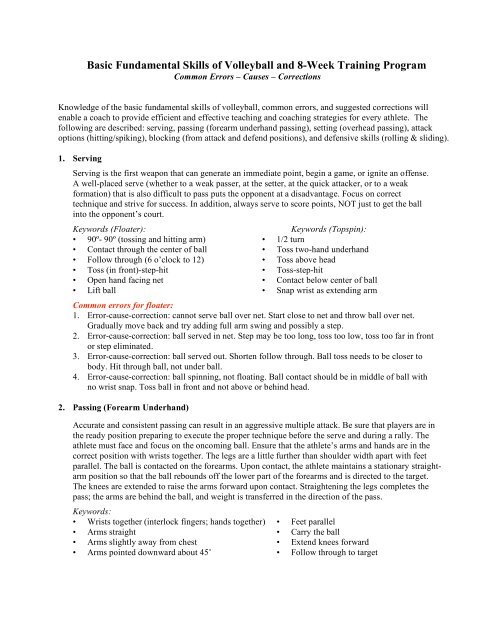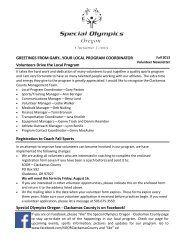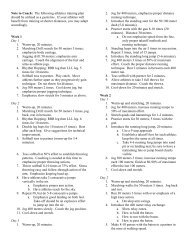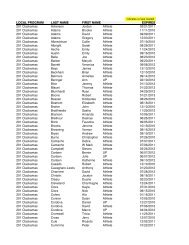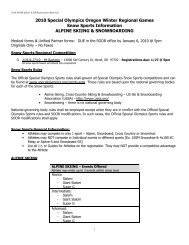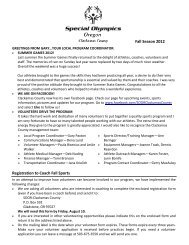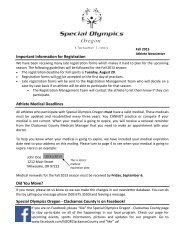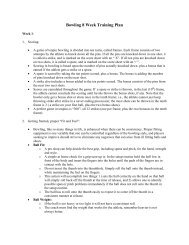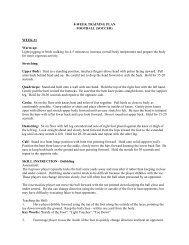Basic Fundamental Skills of Volleyball and 8-Week Training Program
Basic Fundamental Skills of Volleyball and 8-Week Training Program
Basic Fundamental Skills of Volleyball and 8-Week Training Program
You also want an ePaper? Increase the reach of your titles
YUMPU automatically turns print PDFs into web optimized ePapers that Google loves.
<strong>Basic</strong> <strong>Fundamental</strong> <strong>Skills</strong> <strong>of</strong> <strong>Volleyball</strong> <strong>and</strong> 8-<strong>Week</strong> <strong>Training</strong> <strong>Program</strong>Common Errors – Causes – CorrectionsKnowledge <strong>of</strong> the basic fundamental skills <strong>of</strong> volleyball, common errors, <strong>and</strong> suggested corrections willenable a coach to provide efficient <strong>and</strong> effective teaching <strong>and</strong> coaching strategies for every athlete. Thefollowing are described: serving, passing (forearm underh<strong>and</strong> passing), setting (overhead passing), attackoptions (hitting/spiking), blocking (from attack <strong>and</strong> defend positions), <strong>and</strong> defensive skills (rolling & sliding).1. ServingServing is the first weapon that can generate an immediate point, begin a game, or ignite an <strong>of</strong>fense.A well-placed serve (whether to a weak passer, at the setter, at the quick attacker, or to a weakformation) that is also difficult to pass puts the opponent at a disadvantage. Focus on correcttechnique <strong>and</strong> strive for success. In addition, always serve to score points, NOT just to get the ballinto the opponent’s court.Keywords (Floater):Keywords (Topspin):• 90º- 90º (tossing <strong>and</strong> hitting arm) • 1/2 turn• Contact through the center <strong>of</strong> ball • Toss two-h<strong>and</strong> underh<strong>and</strong>• Follow through (6 o’clock to 12) • Toss above head• Toss (in front)-step-hit • Toss-step-hit• Open h<strong>and</strong> facing net • Contact below center <strong>of</strong> ball• Lift ball • Snap wrist as extending armCommon errors for floater:1. Error-cause-correction: cannot serve ball over net. Start close to net <strong>and</strong> throw ball over net.Gradually move back <strong>and</strong> try adding full arm swing <strong>and</strong> possibly a step.2. Error-cause-correction: ball served in net. Step may be too long, toss too low, toss too far in frontor step eliminated.3. Error-cause-correction: ball served out. Shorten follow through. Ball toss needs to be closer tobody. Hit through ball, not under ball.4. Error-cause-correction: ball spinning, not floating. Ball contact should be in middle <strong>of</strong> ball withno wrist snap. Toss ball in front <strong>and</strong> not above or behind head.2. Passing (Forearm Underh<strong>and</strong>)Accurate <strong>and</strong> consistent passing can result in an aggressive multiple attack. Be sure that players are inthe ready position preparing to execute the proper technique before the serve <strong>and</strong> during a rally. Theathlete must face <strong>and</strong> focus on the oncoming ball. Ensure that the athlete’s arms <strong>and</strong> h<strong>and</strong>s are in thecorrect position with wrists together. The legs are a little further than shoulder width apart with feetparallel. The ball is contacted on the forearms. Upon contact, the athlete maintains a stationary straightarmposition so that the ball rebounds <strong>of</strong>f the lower part <strong>of</strong> the forearms <strong>and</strong> is directed to the target.The knees are extended to raise the arms forward upon contact. Straightening the legs completes thepass; the arms are behind the ball, <strong>and</strong> weight is transferred in the direction <strong>of</strong> the pass.Keywords:• Wrists together (interlock fingers; h<strong>and</strong>s together) • Feet parallel• Arms straight • Carry the ball• Arms slightly away from chest • Extend knees forward• Arms pointed downward about 45˚ • Follow through to target
Common errors for passing:1. Error-cause-correction: ball not getting to net. Get closer to ball <strong>and</strong> use more legs.2. Error-cause-correction: ball to low. Angle arms away from body; arms <strong>and</strong> legs follow through atsame time.3. Error-cause-correction: ball too tight to net. Use minimal arm motion; check angle <strong>of</strong> platform.4. Error-cause-correction: ball passed to left side <strong>of</strong> court. Contact ball more on right side <strong>of</strong> thecenter <strong>of</strong> body; follow through toward target.3. Passing (Overh<strong>and</strong>, Overhead or Setting)Overhead passing or setting is the next important part <strong>of</strong> the pass-set-spike sequence for a successfulattack. In fact, an excellent set from a bad pass can still result in a “kill”. The athlete forms a trianglewith the fingers <strong>and</strong> thumbs <strong>of</strong> both h<strong>and</strong>s around the ball above the forehead (thumbs do not touch).Index fingers <strong>and</strong> thumbs form the triangle around 3 panels (18-panel ball). The elbows point slightlyforward. Feet are approximately shoulder-width apart with right foot slightly forward. Knees areslightly bent, <strong>and</strong> body is leaning slightly forward. Eyes are focused on the ball. The athlete receivesthe ball with h<strong>and</strong>s on the outside <strong>of</strong> the ball. The athlete extends the knees <strong>and</strong> straightens the armsto follow-through in the desired direction.Keywords:• H<strong>and</strong>s up early • Wrists straight (not laid back)• Forefingers & thumbs around three panels • Elbows slightly down <strong>and</strong> forward (not out)• H<strong>and</strong>s around the ball • Follow through (straighten arms) <strong>and</strong> hold• Thumbs to cheekbones positionCommon errors for setting:1. Error-cause-correction: ball set too tight to net. Square the hips, knees <strong>and</strong> feet to the 5 position.Keep set 3’ <strong>of</strong>f the net.2. Error-cause-correction: 5-ball set too far inside. Extend follow-through out <strong>and</strong> use arms <strong>and</strong> legstogether. Transfer weight forward.3. Error-cause-correction: ball set too far inside for 15 set. Contact set same as for 5. Follow through<strong>and</strong> allow shoulders to lay back as part <strong>of</strong> follow through.4. Error-cause-correction: 5 set too far outside court. Contact with ball is too low. Follow throughtoo low <strong>and</strong>/or h<strong>and</strong>s too low.Drills introducing the proper setting technique:a. Toss ball above head <strong>and</strong> catch. (Each player st<strong>and</strong>s in correct setting position by straddling aline, preferably the attack line or end line.)1) Toss ball above the head <strong>and</strong> catch ball with h<strong>and</strong>s in correct setting position.2) Toss ball above the head: perform 1/2 turn; repeat <strong>and</strong> perform full 360-degree turn.3) Toss ball in different directions <strong>and</strong> catch ball with h<strong>and</strong>s in correct setting position.4) Toss ball above the head: perform quick-quick (complete half turn <strong>and</strong> back to position).b. Toss two-h<strong>and</strong>ed underh<strong>and</strong> between players (h<strong>and</strong>s <strong>and</strong> body in correct setting position).Toss ball two-h<strong>and</strong>ed underh<strong>and</strong>; partner catches ball with h<strong>and</strong>s in correct setting position.c. Progression for <strong>Training</strong> Setters(Coach at net; setters receive passes when in left back, right back <strong>and</strong> center back positions<strong>and</strong> sets to LF <strong>and</strong> RF.)1) Technique training2) <strong>Training</strong> for setter to move into position3) <strong>Training</strong> for sets near the net in front court (coach in backcourt: LB, CB, & RB)4) <strong>Training</strong> for backcourt sets
4. Attack (Hitting) OptionsThere are several attack options that can be effectively performed in a game. An attacker should beable to hit the following: shots <strong>of</strong>f the block (using the h<strong>and</strong>s), high sets, low sets, sets <strong>of</strong>f the net, <strong>of</strong>fspeedshots, tipping, <strong>and</strong> a variation <strong>of</strong> play sets including back court hitting options. Providing agreat deal <strong>of</strong> practice <strong>and</strong> repetition <strong>of</strong> each will depend on the age <strong>and</strong> ability <strong>of</strong> the athletes. Ensurethe fundamental technique <strong>of</strong> hitting is effective <strong>and</strong> efficient so that it can be performed at a highlevel during competition.With regard to spiking, the athlete must first be able to demonstrate the spiking motion when on thefloor (with modified <strong>and</strong> full arm swing). Second phase is arm swing, which is started with both armsat side <strong>of</strong> body. Arms are taken straight back <strong>and</strong> then thrust forward <strong>and</strong> immediately up. Thirdphase includes athlete jumping <strong>and</strong> spiking. As the athlete begins to jump, her spiking arm is raisedwith elbow shoulder high. At the top <strong>of</strong> jump, the elbow leads as the arm is extended <strong>and</strong> wrist snapsso that the heel <strong>of</strong> the athlete’s h<strong>and</strong> contacts the ball <strong>and</strong> follows through. The athlete must l<strong>and</strong>s<strong>of</strong>tly <strong>and</strong> be in control <strong>of</strong> the l<strong>and</strong>ing. This is a high jump, not a long jump. Fourth phase the athleteuses only the step-close (right-left for right h<strong>and</strong>ers <strong>and</strong> left-right for left h<strong>and</strong>ers) or step 2 <strong>and</strong> 3 <strong>of</strong>the modified spiking approach. Fifth phase includes athlete using a full approach, take-<strong>of</strong>f thencompleting the spiking motion <strong>and</strong> l<strong>and</strong>ing. Right h<strong>and</strong>er (start right foot in front) should take leftright-leftor one step <strong>and</strong> step-close approach. Left h<strong>and</strong>er (start left foot in front) should take rightleft-rightor one step <strong>and</strong> step-close.Keywords:• Quarter turn • Snap wrist• Elbows up • Hit shots• Point to ball (non-hitting arm) • Step, step-close (1, 2, 3 or left-right-left or• Lead with elbow right-left-right)• Extend <strong>and</strong> reachCommon errors for hitting:1. Error-cause-correction: ball hit in net. Ball is dropping too low before contact; ball also too far infront <strong>of</strong> body or contact too much on top <strong>of</strong> ball when snapping wrist.2. Error-cause-correction: ball hit out. Causes are getting under the ball too far <strong>and</strong> not snappingwrist.3. Error-cause-correction: ball hit wide. Elbow is dropped, or there is improper follow through.Check foot position on floor <strong>and</strong> foot position after ball contact.4. Error-cause-correction: ball with no spin; Ball contact may be too low, follow through too low, orball too much to right or left <strong>of</strong> body.5. Blocking – Attack; DefendA well-timed <strong>and</strong> effective block diffuses an <strong>of</strong>fensive attack. The athlete is near the net, moves intoposition with h<strong>and</strong>s up quickly. Athlete focuses on the ball <strong>and</strong> jumps vertically so that maximumheight is achieved when the ball is above net <strong>and</strong> contacted. Arms are raised <strong>and</strong> extended above thehead; h<strong>and</strong>s are close together with fingers open; wrists are in line with arms (wrist parallel), <strong>and</strong>h<strong>and</strong>s are slightly forward. A firm <strong>and</strong> straight-arm position is maintained so that the ball rebounds<strong>of</strong>f h<strong>and</strong>s <strong>and</strong> is not struck. If possible, athlete reaches up <strong>and</strong> over the net with arms <strong>and</strong> h<strong>and</strong>spointed in a downward position for a rebound. The athlete l<strong>and</strong>s facing the net while keeping theupper body in control <strong>and</strong> knees bent to absorb the shock. Depending upon whether right side or leftis blocking will determine which h<strong>and</strong> should be turned inside.
Keywords:• H<strong>and</strong>s at shoulders • Jump & extend• Elbows forward • H<strong>and</strong>s forward• Wrists parallel • Straighten armsCommon errors for blocking:1. Error-cause-correction: ball being blocked outside <strong>of</strong> court. H<strong>and</strong>s are facing outside <strong>of</strong> court.2. Error-cause-correction: ball comes down in front <strong>of</strong> player. Arms are closer to net. Player isjumping late <strong>and</strong> not getting to the outside blocker.3. Error-cause-correction: ball going between players (seam). Inside h<strong>and</strong>s are not closing the holein the block.4. Error-cause-correction: not closing <strong>of</strong>f enough area <strong>of</strong> court. Outside blocker is setting the blocktoo far outside.6. Defensive <strong>Skills</strong> – Rolling; SlidingWhen the ball does not come directly at an athlete, it may be impossible to play the ball from aregular underh<strong>and</strong> passing st<strong>and</strong>ing position. The athlete still focuses on the ball <strong>and</strong> takes a step withthe near foot in the direction <strong>of</strong> the oncoming ball. The body is extremely low when playing the ball.To ensure that the athlete does not hurt himself/herself, the athlete will continue the momentum <strong>and</strong>either slide or roll out <strong>of</strong> the play. The goal is to get the ball up to the target <strong>and</strong> safely return to theready position as quickly as possible.Keywords:• Wrists together • Read the set• Arms straight • Platform behind ball• Relax <strong>and</strong> cushion • Reach, kick-up <strong>and</strong> slide armCommon errors for defense:1. Error-cause-correction: not getting to ball before it hits floor. Read the hitter/blocker <strong>and</strong> reactafter reading.2. Error-cause-correction: ball coming up too low. Contact under the ball by staying low.3. Error-cause-correction: ball not getting to target. Watch the ball rebound <strong>of</strong>f arms. Stay low whenplaying the ball.4. Error-cause-correction: missing ball when attacker hits ball <strong>of</strong>f blockers h<strong>and</strong>s. React to ballimmediately when hitter attacks ball. Watch follow through <strong>of</strong> hitter <strong>and</strong> look at blockers h<strong>and</strong>s.What follows is an 8-week training program <strong>of</strong> 8 individual training plans. It is suggested that a team trainat least twice a week. Repeat the same practice for both sessions to provide necessary repetition <strong>and</strong>reinforcement <strong>of</strong> volleyball skills <strong>and</strong> strategies. It is also suggested that Volley Lites be used for lowerability athletes. The ball is the same size as regulation volleyball, but it is s<strong>of</strong>ter <strong>and</strong> lighter. Lower abilityathletes will gain early success with Volley Lites. Lastly, it is suggested that competition is arranged nolater than the 4 th week. It is competition that will provide a measure <strong>of</strong> success <strong>and</strong> identify training needs.During each practice, more than one drill is suggested. However, progress only at the rate for yourathletes. Do not rush through drills or spend more than 10 minutes doing any one thing. Vary the drill,changing direction or frequency <strong>of</strong> successful touches, so that attention is maintained <strong>and</strong> skilldevelopment is fostered.
<strong>Volleyball</strong> <strong>Week</strong>-1 <strong>Training</strong> Plan20 minutes Warm-up• Jogging: 2 mins. around court• Stretching: Calves, hamstrings, quads, groin, shoulders, <strong>and</strong> arms45 minutes Skill Work (Use Volley Lites to start season <strong>and</strong> for lower ability athletes.)• Introduction to Passing [SSP, page 57, drill 1 & 2]- Athletes practice assuming correct passing “ready” position:face & focus on oncoming ball; h<strong>and</strong>-in-h<strong>and</strong> with wriststogether; arms away from body. Practice repeating position oncomm<strong>and</strong>.- Passer has partner as a tosser/target; passer is at attack line <strong>and</strong> tosser /target at net.- Goal: pass a prescribed number <strong>of</strong> balls <strong>and</strong> then change target with passer. Aftertosser/target tosses ball underh<strong>and</strong> to passer, he/she raises h<strong>and</strong>s above head as a target.As passer gets better, she/he will move back to the end line <strong>and</strong> repeat same drill topartner’s h<strong>and</strong>s raised above head (tosser at net; passer at attack line. Make 5 successfulpasses then passer <strong>and</strong> tosser/target switch roles.P P PT • T • T•T • T • T•P P P• Introduction to Serving [SSP, page 56, drill 1-2]- Demonstrate floater <strong>and</strong> introduce underh<strong>and</strong> serve (for thoselower skilled).- Serve to a partner who catches the ball. Server st<strong>and</strong>s on endline <strong>and</strong> target st<strong>and</strong> on attack line.- After 3 serves, partners begin to move closer to the net, then toother side <strong>of</strong> net.S• S • S• S•P P P PP P P PS• S• S• S•• Introduction to Setting (Overhead Passing) [SSP, page 59, drill 1 & 2]- Assume setting position: form triangle with fingers <strong>and</strong>thumbs around ball above forehead (thumbs do not touch).Elbows are slightly forward; right foot slightly forward.- Perform same drill as for passing; however, ball is tossed sothat passer receives it overhead. Setter is at attack line;tosser/target is at net. After 3 successful sets, setter moves stepbackward.S S ST• T• T•T• T• T•S S S15 minutes Team Concept for Team• Team play: get into positions: RB-RF-CF-LF-LB-CB. Practice ready position. Coach tossesball over net for team to put skills in practice. Goal is to receive ball, pass to teammate, <strong>and</strong>forearm pass over net. Each team has chance to succeed. Rotate on exchange <strong>of</strong> possession.Individual <strong>Skills</strong> Work with ISC Athletes (See Special Olympics volleyball rules for event set-up<strong>and</strong> scoring.)• Demonstrate the Forearm Passing event; conduct <strong>and</strong> score.Strengthening & Conditioning Activities: Jump-the-Lines; Setups; Pushups10 minutes Bring team together for cool-down stretching <strong>and</strong> reward efforts (winner’s circle witheach athlete receiving accolades); coach notes one positive per each athlete.
<strong>Volleyball</strong> <strong>Week</strong>-2 <strong>Training</strong> Plan20 minutes Warm-up• Jogging: 2 mins. around court• Stretching: Calves, hamstrings, quads, groin, shoulders, <strong>and</strong> arms45 minutes Skill Work (Use Volley Lites to start season <strong>and</strong> for lower ability athletes.)• Review Passing [SSP, page 57, drill 1-2-3]- Athletes practice correct passing “ready” position.- Passer has partner as a tosser/target; passer is at attack line <strong>and</strong>tosser /target at net as yesterday. Goal: pass a prescribednumber <strong>of</strong> balls <strong>and</strong> then change target with passer.- Change drill so that passer is in back court <strong>and</strong> passes tocenter (different angle <strong>and</strong> follow through). After 3 attempts,rotate tosser to passer to target to tosser.PasserTosser TargetTosser TargetPasser• Review Serving [SSP, page 56, drill 3-4]- Review the floater <strong>and</strong> underh<strong>and</strong> serve (for those lowerskilled).- Serve to a partner who catches the ball. Server st<strong>and</strong>s at net.- After 3 serves each, partners switch roles.- Practice serving over net; partners become serves, too; no oneis at net. Allow players to start between attack line <strong>and</strong> end lineif needed, then gradually step back as confidence <strong>and</strong> success isachieved.S• S • S• S•P P P PP P P PS• S• S• S•• Review Setting (Overhead Passing) [SSP, page 60, drill 3-4]- Assume setting position: emphasize good technique.- Perform same drill as for passing; however, ball is tossed sothat passer receives it overhead. Setter is at attack line;tosser/target is at net. After 3 successful sets, setter moves stepbackward. Rotate setter to target to tosser to setter.PasserTosser TargetTosser TargetPasser15 minutes Team Concept for Team• Team play: get into positions: RB-RF-CF-LF-LB-CB. Practice ready position. Coach tossesball over net for team to put skills in practice. Goal is to receive ball, pass to teammate, <strong>and</strong>forearm pass over net. Each team has chance to succeed. Rotate on exchange <strong>of</strong> possession.• Add short serve (serving from 10’ inside end line).Individual <strong>Skills</strong> Work with ISC Athletes (See Special Olympics volleyball rules.)• Demonstrate the Overhead Passing (Setting) event; conduct <strong>and</strong> score. Chart performance inwhich to compare player improvements.Strengthening & Conditioning Activities: Jump-the-Lines; Setups; Pushups10 minutes Bring team together for cool-down stretching <strong>and</strong> reward efforts (winner’s circle witheach athlete receiving accolades); assistant coaches note one positive per each athlete.
<strong>Volleyball</strong> <strong>Week</strong>-3 <strong>Training</strong> Plan20 minutes Warm-up• Jogging: 2 mins. around court• Stretching: Calves, hamstrings, quads, groin, shoulders, <strong>and</strong> arms45 minutes Skill Work (Use Volley Lites to start season <strong>and</strong> for lower ability athletes.)• Review Passing [SSP, page 59, drill 6]- Athletes practice correct passing “ready” position.- Passer is in back court <strong>and</strong> passes to center (different angle<strong>and</strong> follow through). After 3 attempts, rotate tosser to passer totarget to tosser.• Review Serving - briefly [SSP, page 56]- Review floater <strong>and</strong> underh<strong>and</strong> serve (for those lower skilled).- Practice serving over net. Allow players to start between attackline <strong>and</strong> end line if needed, then gradually step back asconfidence <strong>and</strong> success is achieved.• Review Setting (Overhead Passing) [SSP, page 60-61, drill 5-6-7]- Assume setting position: emphasize good technique.- Perform same drill as for passing; however, ball is tossed sothat passer receives it overhead. Setter is at attack line;tosser/target is at net. After 3 successful sets, setter moves stepbackward. Rotate setter to target to tosser to setter.S• S • S• S•PasserPasserTosser TargetTosser TargetTosser TargetTosser TargetPasserPasserS• S• S• S•• Introduce Spiking [SSP, page 62, drill 1-2]- Demonstrate arm swing <strong>and</strong> spiking motion.- Coach holds ball while hitter (H) performs motion <strong>and</strong> strikesball. (Start close to net.) Gradually put in toss st<strong>and</strong>ing close toathlete.- Hitter follows hit, shags ball, <strong>and</strong> takes to other side.H H H H HC•C•H H H H H15 minutes Team Concept for Team• Team play: get into positions: RB-RF-CF-LF-LB-CB. Practice ready position. Coach tossesball over net for team to put skills in practice. Goal is to receive ball, pass to teammate, <strong>and</strong>forearm pass over net. Each team has chance to succeed. Rotate on exchange <strong>of</strong> possession.• Add short serve (serving from 10’ inside end line).• Practice Team-receive positions <strong>and</strong> scrimmage. May need to intersperse coaches amongathletes with goal <strong>of</strong> keeping the ball in play.Individual <strong>Skills</strong> Work with ISC Athletes (See Special Olympics volleyball rules.)• Demonstrate the Serving event; conduct <strong>and</strong> score. Chart performance in which to compareplayer improvements.Strengthening & Conditioning Activities: Jump-the-Lines; Setups; Pushups10 minutes Bring team together for cool-down stretching <strong>and</strong> reward efforts,• Go over plans for competition/scrimmage next week.• Check on uniforms; provide information on logistics; identify parent <strong>and</strong> coach responsibilities..
<strong>Volleyball</strong> <strong>Week</strong>-4 <strong>Training</strong> Plan20 minutes Warm-up• Jogging: 2 mins. around court• Stretching: Calves, hamstrings, quads, groin, shoulders, <strong>and</strong> arms30 minutes Skill Work (Use Volley Lites to start season <strong>and</strong> for lower ability athletes.)• Review Spiking [SSP, page 62-63, drill 3-4]- Practice arm swing <strong>and</strong> spiking motion.- Coach holds ball while hitter (H) performs motion <strong>and</strong> strikesball. (Start close to net.) Toss ball st<strong>and</strong>ing close to athlete.- Hitter follows hit, shags ball, <strong>and</strong> takes to other side.- Coach tosses ball to setter who sets for hitter; same rotation.H H H H HC•SS•CH H H H H• Review Serve-Pass-Spike [SSP, page 65, drill 1 a-b-c]- 3 passers are on one side <strong>of</strong> the court, then add a fourth passerwith a spiker.- Start with coach throwing ball over net to simulate what willoccur with servers, but at lesser challenge.- Passers rotate after 3 good serves or 3 good passes.LBTLF CFS S• S• S•• Introduce Defense [SSP, page 64]- Coach will toss balls as though spiking. Gradually, coach willmove in all frontcourt positions <strong>and</strong> then move to other side <strong>of</strong>court, across net, hitting while st<strong>and</strong>ing on chair or table.- Athletes move to dig ball up. Goal is to get to the ball <strong>and</strong> intothe air at least head height.D D DD D DD D DC30 minutes Team Concept for Team• Team scrimmage against coaches, parents or opponent.• Enforce rules; prompt positioning <strong>and</strong> movementIndividual <strong>Skills</strong> Work with ISC Athletes (See Special Olympics volleyball rules.)• ISC athletes begin their work while other athletes are involved with spiking.• Conduct all three events if possible; if not, conduct the Serving <strong>and</strong> Overhead Passing events;conduct <strong>and</strong> score. Chart performance <strong>and</strong> compare player improvements.10 minutes Bring team together for cool-down stretching <strong>and</strong> reward efforts,• Go over plans for competition/scrimmage.• Check on uniforms; provide information on logistics; identify parent <strong>and</strong> coach responsibilities.
<strong>Volleyball</strong> <strong>Week</strong>-5 <strong>Training</strong> Plan20 minutes Warm-up• Jogging: 2 mins. around court• Stretching: Calves, hamstrings, quads, groin, shoulders, <strong>and</strong> arms25 minutes Skill Work (Use Volley Lites to start season <strong>and</strong> for lower ability athletes.)• Introduce Blocking [SSP, page 63]- Partners line up on opposite sides <strong>of</strong> the net. They jump up <strong>and</strong>try to touch h<strong>and</strong>s without touching the net. After l<strong>and</strong>ing, theymove <strong>and</strong> block in the next position- Athlete should st<strong>and</strong> on stable table <strong>and</strong> be anchored by coach.Another coach will hit ball into block so athlete can practiceblocking form. Net may be lowered for lower ability athletes.- In groups <strong>of</strong> 3, one person overh<strong>and</strong> tosses ball so it is comingover net. Athlete jumps up <strong>and</strong> blocks ball over net.H H HH H HH H HH H H• Review Spiking [SSP, page 66]- Coach tosses to LF, CF, RF for their hitting- From LB position, coach tosses to setter who sets hitters.- From RB position, coach tosses to setter who sets hitters.SH H HH H HC•45 minutes Team Concept for Team• Team receive formations [SSP, page 65]- Set up in team-receive positions with all 6 team members.- Ball is passed over net to passers; passers pass ball to target.- Next: setter sets to hitting lines <strong>and</strong> spiker catches ball. There is no spiking.- Team is in “W” serve-receive formation with one server in opposite court who serves toteammates. Start server in mid-court <strong>and</strong> move back.• Team <strong>of</strong>fense [SSP, page 67]- Same as above, but add hitting.• Play shortened game/match, putting all skills into play.• Perform <strong>Volleyball</strong> <strong>Skills</strong> Assessment Test (VSAT) for Spiking; score <strong>and</strong> recordperformance.Individual <strong>Skills</strong> Work with ISC Athletes (See Special Olympics volleyball rules.)• ISC athletes begin their work while other athletes are involved with spiking.• Conduct all three events if possible; if not, conduct the Serving <strong>and</strong> Forearm Passing events;conduct <strong>and</strong> score. Chart performance <strong>and</strong> compare player improvements.10 minutes Bring team together for cool-down stretching <strong>and</strong> reward efforts (winner’s circle witheach athlete receiving accolades).• Teammates note one positive per each athlete (reward effort with blocking, especially today).• Go over plans for competition/scrimmage (uniforms; logistics; parent <strong>and</strong> coachresponsibilities).
<strong>Volleyball</strong> <strong>Week</strong>-6 <strong>Training</strong> Plan20 minutes Warm-up• Jogging: 2 mins. around court• Stretching: Calves, hamstrings, quads, groin, shoulders, <strong>and</strong> arms20 minutes Skill Work (Use Volley Lites to start season <strong>and</strong> for lower ability athletes.)• Review Blocking [SSP, page 63]- Partners line up on opposite sides <strong>of</strong> the net. They jump up <strong>and</strong>try to touch h<strong>and</strong>s without touching the net. After l<strong>and</strong>ing, theymove <strong>and</strong> block in the next position- In groups <strong>of</strong> 3, one person overh<strong>and</strong> tosses ball so it is comingover net. Athlete jumps up <strong>and</strong> blocks ball over net.H H HH H HH H HH H H• Review Serve-Pass-Spike [SSP, page 65, drill 1 a-b-c]- 3 passers are on one side <strong>of</strong> the court with a spiker.- Start with coach throwing ball over net to simulate what willoccur with servers, but at lesser challenge.- Passers rotate after 3 good serves or 3 good passes.45 minutes Team Concept for Team• Review positions with transition from defense to <strong>of</strong>fense.- Set up in team-receive positions with all 6 team members.- Ball is passed over net to passers; passers pass ball to target.- Next: setter sets to hitting lines <strong>and</strong> spiker catches ball. There is no spiking.- Team is in “W” serve-receive formation with one server in opposite court who serves toteammates. Start server in mid-court <strong>and</strong> move back.• Review team-receive positions. [SSP, page 65]- Set up in team-receive positions with all 6 team members.- Ball is passed over net to passers; passers pass ball to target.- Next: setter sets to hitting lines <strong>and</strong> spiker catches ball. There is no spiking.- Team is in “W” serve-receive formation with one server in opposite court who serves toteammates. Start server in mid-court <strong>and</strong> move back.• Scrimmage with coaches or opponent.• Perform the <strong>Volleyball</strong> <strong>Skills</strong> Assessment Test (VSAT) for Forearm Passing; score <strong>and</strong> recordperformances.LB RBTLF CFS S• S• S•Individual <strong>Skills</strong> Work with ISC Athletes (See Special Olympics volleyball rules.)• ISC athletes begin their work while other athletes are involved with spiking.• Conduct all three events if possible; if not, conduct the Overhead Passing <strong>and</strong> ForearmPassing events; conduct <strong>and</strong> score. Chart performance <strong>and</strong> compare player improvements.10 minutes Bring team together for cool-down stretching <strong>and</strong> reward efforts (winner’s circle witheach athlete receiving accolades).• Teammates note one positive per each athlete (reward covering & helping each other).• Go over plans for competition/scrimmage (uniforms; logistics; parent <strong>and</strong> coachresponsibilities).
<strong>Volleyball</strong> <strong>Week</strong>-7 <strong>Training</strong> Plan20 minutes Warm-up• Jogging: 2 mins. around court• Stretching: Calves, hamstrings, quads, groin, shoulders, <strong>and</strong> arms20 minutes Skill Work (Use Volley Lites to start season <strong>and</strong> for lower ability athletes.)• Review Serve-Pass-Spike [SSP, page 65, drill 1 a-b-c]- 3 passers are on one side <strong>of</strong> the court with a spiker.- Start with coach throwing ball over net to simulate what willoccur with servers, but at lesser challenge.- Passers rotate after 3 good serves or 3 good passes.• Review Defense/Digging [SSP, page 64]- Coach will toss balls as though spiking. Gradually, coach willmove in all frontcourt positions <strong>and</strong> then move to other side <strong>of</strong>court, across net, hitting while st<strong>and</strong>ing on chair or table.- Athletes move to dig ball up. Goal is to get to the ball <strong>and</strong> intothe air at least head height.LB RBTLF CFD D DD D DD D DCS S• S• S•45 minutes Team Concept for Team• Review positions with transition from defense to <strong>of</strong>fense.- Set up in team-receive positions with all 6 team members.- Ball is passed over net to passers; passers pass ball to target.- Next: setter sets to hitting lines <strong>and</strong> spiker catches ball. There is no spiking.- Team is in “W” serve-receive formation with one server in opposite court who serves toteammates. Start server in mid-court <strong>and</strong> move back.• Review team-receive positions. [SSP, page 65]- Set up in team-receive positions with all 6 team members.- Ball is passed over net to passers; passers pass ball to target.- Next: setter sets to hitting lines <strong>and</strong> spiker catches ball. There is no spiking.- Team is in “W” serve-receive formation with one server in opposite court who serves toteammates. Start server in mid-court <strong>and</strong> move back.• Scrimmage with coaches or opponent.• Perform the <strong>Volleyball</strong> <strong>Skills</strong> Assessment Test (VSAT) <strong>of</strong> Bump-Set; score <strong>and</strong> recordperformances.Individual <strong>Skills</strong> Work with ISC Athletes (See Special Olympics volleyball rules.)• ISC athletes begin their work while other athletes are involved with spiking.• Conduct all three events if possible; if not, conduct the Overhead Passing <strong>and</strong> Serving events;conduct <strong>and</strong> score. Chart performance <strong>and</strong> compare player improvements.10 minutes Bring team together for cool-down stretching <strong>and</strong> reward efforts (winner’s circle witheach athlete receiving accolades).• Teammates note one positive per each athlete (reward teamwork, especially today).• Go over plans for competition/scrimmage (uniforms; logistics; parent <strong>and</strong> coachresponsibilities).
<strong>Volleyball</strong> <strong>Week</strong>-8 <strong>Training</strong> Plan20 minutes Warm-up• Jogging: 2 mins. around court• Stretching: Calves, hamstrings, quads, groin, shoulders, <strong>and</strong> arms10 minutes Skill Work (Use Volley Lites to start season <strong>and</strong> for lower ability athletes.)• Review Serve-Pass-Spike [SSP, page 65, drill 1 a-b-c]- 3 passers are on one side <strong>of</strong> the court with a spiker.- Start with coach throwing ball over net to simulate what willoccur with servers, but at lesser challenge.- Passers rotate after 3 good serves or 3 good passes.50 minutes Team Concept for Team• Brief review <strong>of</strong> positions with transition from defense to <strong>of</strong>fense.- Team is in “W” serve-receive formation with one server in opposite court who serves toteammates. Start server in mid-court <strong>and</strong> move back.- Setter sets to hitting lines <strong>and</strong> spiker catches ball. Spike or forearm pass over net.• Scrimmage with coaches or parents. Last practice before culminating event.LB RBTLF CFS S• S• S•Individual <strong>Skills</strong> Work with ISC Athletes (See Special Olympics volleyball rules.)• ISC athletes begin their work while other athletes are involved with spiking.• Conduct all three events if possible; if not, conduct the Overhead Passing <strong>and</strong> Serving events;conduct <strong>and</strong> score. Chart performance <strong>and</strong> compare player improvements.10 minutes Bring team together for cool-down stretching <strong>and</strong> reward efforts (winner’s circle witheach athlete receiving accolades); teammates note one positive per each athlete rewardingteamwork, especially today.• Go over plans for final competition (uniforms; logistics; parent <strong>and</strong> coach responsibilities).• Head coach closes with emphasis on great team effort <strong>and</strong> what each has contributed to team.


